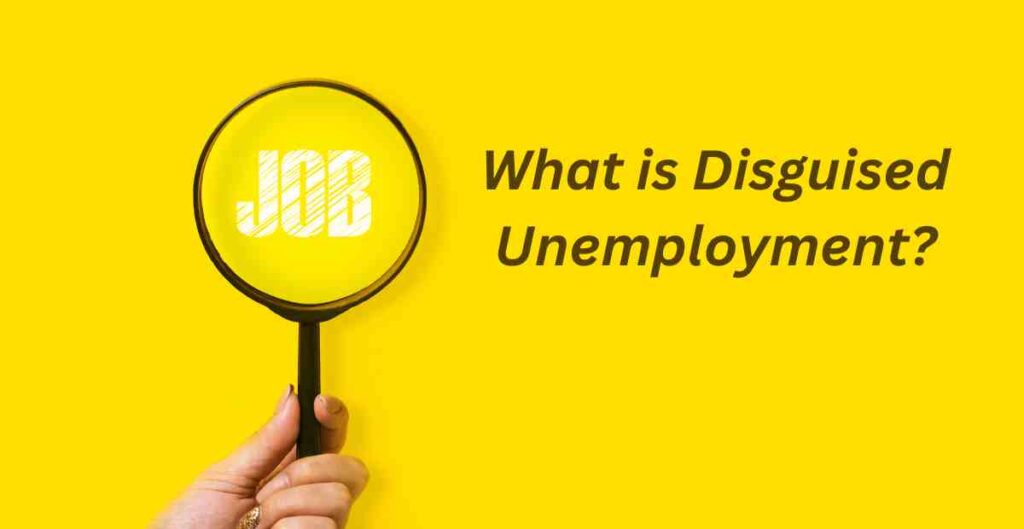Come along on our journey into a lively marketplace packed with vendors showcasing their merchandise – It appears as though they’re all making worthwhile contributions towards boosting the local economy! But in truth? On closer inspection? You might discern some vendors who aren’t earning enough revenues to justify having set up shop there- this is known as disguised unemployment! An ongoing situation that’s more pervasive than we’d like to admit. Join us now; let’s delve deep into the intricacies of disguised unemployment, it’s far-reaching impact, and possible solutions to mitigate its negative effects.
What is Disguised Unemployment?

A unique type of joblessness exists where workers appear employed but do not contribute substantially to productivity – this is known as disguised unemployment. This form of unemployment usually arises in densely populated sectors where removing some staff would have negligible effects on the final output.
- Agricultural Disguised Unemployment: In many developing countries, agriculture is a primary source of livelihood. However, due to the seasonal nature of this sector, there is often an excess of labor during off-peak periods. This surplus labor, while appearing to be employed, does not contribute significantly to productivity.
- Industrial Disguised Unemployment: This form of disguised unemployment is prevalent in industries where labor is not fully utilized. For instance, a factory may employ more workers than necessary, leading to inefficiencies and reduced productivity per worker.
The Impact of Disguised Unemployment

Disguised unemployment is not just an economic issue; it’s a social one too. It affects individuals, families, and communities, leading to a lower standard of living and increased poverty rates.
- Economic Impact: Disguised unemployment leads to a waste of human resources. The economy loses out on the potential output that could have been generated if these individuals were employed in productive roles.
- Social Impact: On a personal level, individuals in disguised unemployment often face financial instability and low self-esteem. They may feel undervalued and trapped in their current roles, leading to a decline in mental health.
The Causes of Disguised Unemployment
Understanding the causes of disguised unemployment is crucial for devising effective strategies to combat it. Here are some of the key factors contributing to this issue:
- Overpopulation: Overpopulation leads to an oversupply of labor, particularly in sectors like agriculture and small-scale industries. This surplus labor often results in disguised unemployment.
- Lack of Skill Development: In many cases, individuals lack the necessary skills or training to secure productive employment. As a result, they end up in roles where they are underutilized.
- Technological Advancements: While technology has undoubtedly improved productivity, it has also led to job displacement in certain sectors. Workers who are unable to adapt to these changes may find themselves in a state of disguised unemployment.
- Economic Policies: In some cases, economic policies may inadvertently contribute to disguised unemployment. For instance, subsidies in the agricultural sector may encourage overemployment, leading to disguised unemployment.
Strategies to Reduce Disguised Unemployment

Addressing disguised unemployment requires a multi-faceted approach. Here are some strategies that can help:
-
Skill Development and Education:
By investing in education and skill development, we can equip individuals with the tools they need to secure productive employment. This not only reduces disguised unemployment but also contributes to economic growth.
-
Promoting Entrepreneurship:
Encouraging entrepreneurship can create new job opportunities, reducing the reliance on traditional sectors prone to disguised unemployment.
-
Technological Adaptation:
Providing training to help workers adapt to technological changes can prevent job displacement and reduce disguised unemployment.
-
Policy Reforms:
Revising economic policies to discourage overemployment can help mitigate disguised unemployment. This could involve reducing subsidies in overpopulated sectors or implementing policies that encourage labor mobility.
Conclusion
The concept of disguised unemployment is intricate and carries significant ramifications. However, it is conquerable by comprehending its origins and effects. Our economy can benefit from each member’s constructive input, which is why we must facilitate an environment that allows us to achieve this goal.
As we conclude, we invite you to visit Yunicsolutions.com. Our team of HR consultants is committed to helping businesses and individuals navigate the complexities of the job market. Whether you’re an employer looking to optimize your workforce or an individual seeking career guidance, we’re here to help. Together, we can work towards a future where everyone has the opportunity to contribute meaningfully to our economy.
FAQs
1. What is Disguised Unemployment? Disguised unemployment refers to a situation where more people are employed than are necessary for production. These extra workers do not contribute to productivity but appear to be employed.
2. Can you provide an example of Disguised Unemployment? A common example of disguised unemployment is in the agricultural sector of developing countries, where a large number of people are employed but many of them are not necessary for the amount of work available.
3. How do you define Disguised Unemployment? Disguised unemployment is defined as a form of unemployment where individuals appear to be employed but their contribution to the total output is negligible or zero.
4. What is the meaning of Disguised Unemployment? The term “disguised unemployment” means that although individuals are employed and working, they are surplus to the requirements of the job and their removal would not affect the overall productivity.
5. What do you understand by Disguised Unemployment? Disguised unemployment is a situation where more people are working than are needed. Despite being employed, these extra workers do not add to the total output, making their employment ineffective.
6. What are the causes of Disguised Unemployment? The causes of disguised unemployment include overpopulation, lack of skill development, technological advancements, and certain economic policies.

